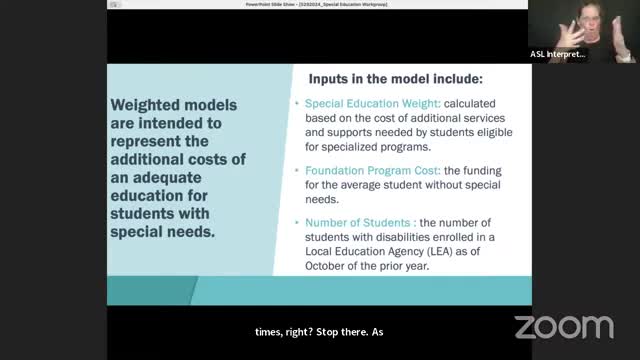Maryland education leaders debate special education funding formula effectiveness
May 29, 2024 | Maryland Department of Education, School Boards, Maryland

This article was created by AI summarizing key points discussed. AI makes mistakes, so for full details and context, please refer to the video of the full meeting. Please report any errors so we can fix them. Report an error »

The Maryland Department of Education's recent Blueprint Special Education Workshop highlighted critical discussions surrounding the state's funding formula for special education. The meeting, held on May 29, 2024, focused on the single weight formula used to allocate resources to local education agencies (LEAs) based on the number of students with disabilities.
At the heart of the conversation was the current special education weight of 0.99, which is applied to the foundation program cost of $8,789 per average student without special needs. This formula aims to ensure that funding reflects the additional costs associated with educating students with disabilities. However, concerns were raised about the formula's effectiveness, particularly regarding its ability to address the needs of schools with students who have significant special needs.
One significant point of contention was the rule that mandates 75% of the allocated funds follow the student to their school. While this approach aims to direct more resources to schools with higher populations of students with disabilities, it may inadvertently disadvantage schools that serve fewer students but have a higher concentration of those with severe needs. This could lead to underfunding in critical areas where support is most needed.
The workshop also touched on the broader context of special education funding, noting that Maryland's model is part of a layered funding system that includes additional resources for multilingual learners and economically disadvantaged students. However, it was emphasized that these additional weights were not designed to compensate for inadequacies in special education funding.
As discussions continue, there is a growing call for a differentiated weight system that accounts for the severity of disabilities, as recommended by the Kerwin Commission. This shift could lead to more equitable funding that better meets the diverse needs of students with disabilities across the state.
The meeting concluded with a recognition of the complexities surrounding special education funding, including transportation costs and the lack of a reimbursement model for LEAs with high-cost placements. As Maryland navigates these challenges, the focus remains on ensuring that all students receive the support they need to thrive in their educational environments.
At the heart of the conversation was the current special education weight of 0.99, which is applied to the foundation program cost of $8,789 per average student without special needs. This formula aims to ensure that funding reflects the additional costs associated with educating students with disabilities. However, concerns were raised about the formula's effectiveness, particularly regarding its ability to address the needs of schools with students who have significant special needs.
One significant point of contention was the rule that mandates 75% of the allocated funds follow the student to their school. While this approach aims to direct more resources to schools with higher populations of students with disabilities, it may inadvertently disadvantage schools that serve fewer students but have a higher concentration of those with severe needs. This could lead to underfunding in critical areas where support is most needed.
The workshop also touched on the broader context of special education funding, noting that Maryland's model is part of a layered funding system that includes additional resources for multilingual learners and economically disadvantaged students. However, it was emphasized that these additional weights were not designed to compensate for inadequacies in special education funding.
As discussions continue, there is a growing call for a differentiated weight system that accounts for the severity of disabilities, as recommended by the Kerwin Commission. This shift could lead to more equitable funding that better meets the diverse needs of students with disabilities across the state.
The meeting concluded with a recognition of the complexities surrounding special education funding, including transportation costs and the lack of a reimbursement model for LEAs with high-cost placements. As Maryland navigates these challenges, the focus remains on ensuring that all students receive the support they need to thrive in their educational environments.
View full meeting
This article is based on a recent meeting—watch the full video and explore the complete transcript for deeper insights into the discussion.
View full meeting
